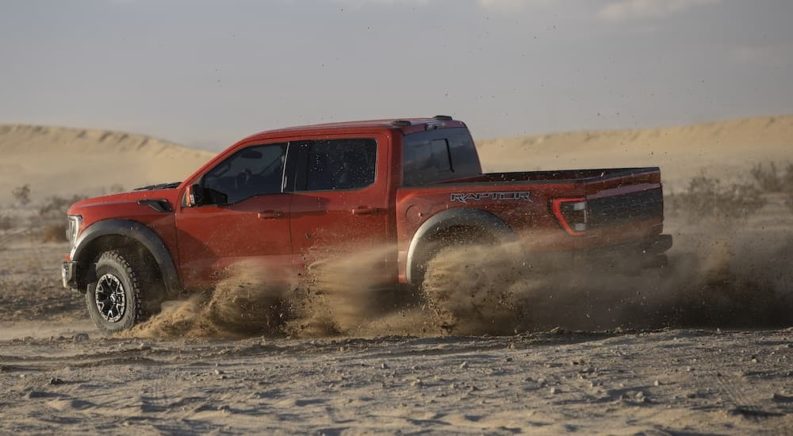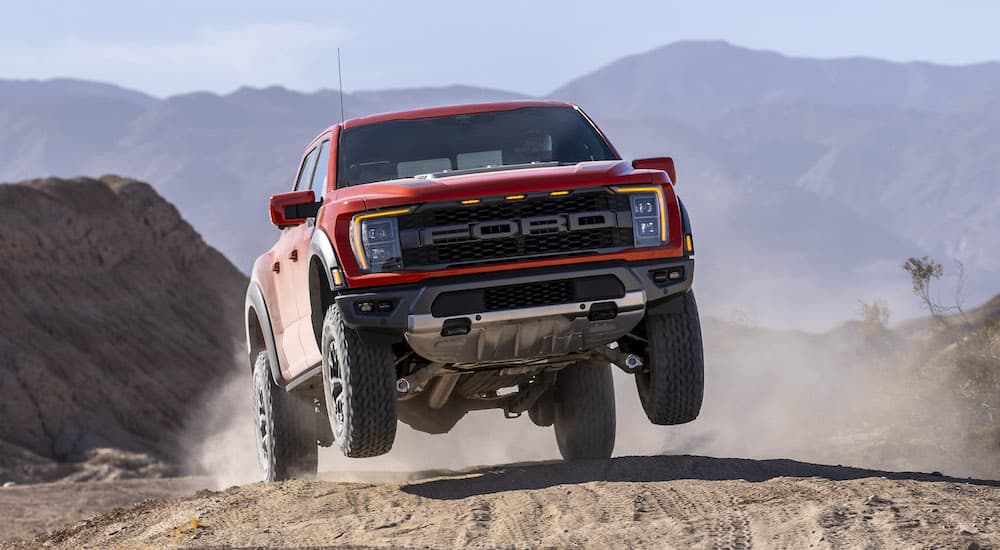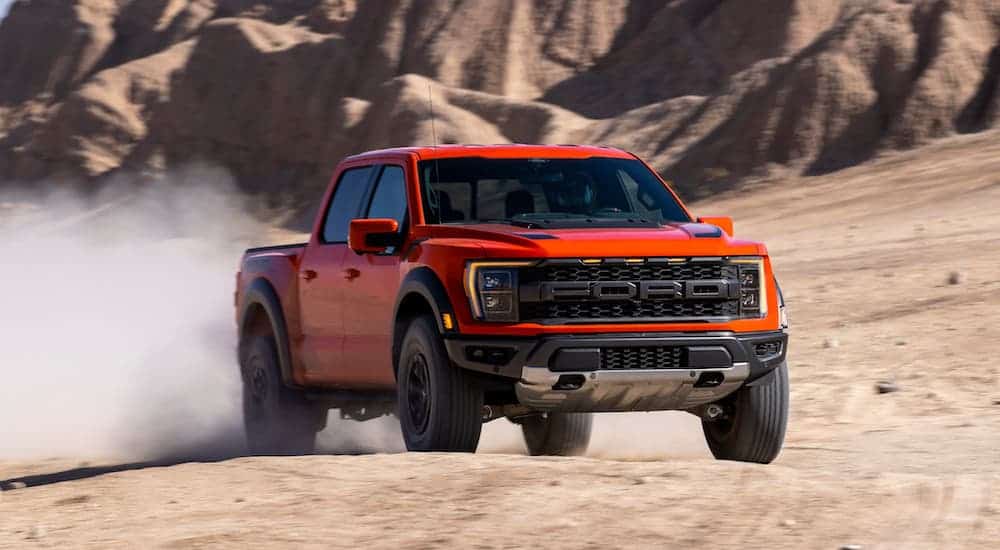The end of 2020 brought with it much exciting news, but at the time, auto fans like me were stuck waiting for details on the 2021 Ford F-150 Raptor. Never before in the Raptor’s 9-year history had so much been riding on the announcement of the next model year’s specs! The all-new Ram TRX was stomping all over the outgoing Raptor, and Ford’s few technical advantages would do little to sway a prospective buyer in this segment. Caught unawares by the all-new truck war (Baja edition), Ford was suddenly on the back foot and in need of an answer to remain competitive.
At the time, I studied this mismatch to discuss what Ford’s ideal response should be to preserve the edges it has while making gains in other areas. Of course, many of Ford’s plans were surely near fruition by that time and firmly set in stone, but for the rest of us, it was all conjecture. Now with the benefit of hindsight, we can look again at this matchup between the industry’s most ridiculous vehicles and see if Ford’s counter strike is a good one.
Lean Into Your Strengths
A year and a half ago, the biggest reasons to get a Raptor over a TRX were all about size. There’s no getting around the fact that getting around in the TRX was a harder task than in the Raptor because it was bigger in every single way. Physically larger and heavier, with a thirstier engine, daily living with the TRX, especially in anything resembling an urban or even suburban environment, was substantially more taxing, physically and financially, than with the Raptor.
This remains largely unchanged today, thank goodness. While the 2021 Raptor is barely ¼” shorter than the TRX––and its wheelbase is actually ¼” longer––a width of 86.6″ against Ram’s 88″ and a height of 79.8″ vs. 80.9″ gives the F-150 the slightest of advantages for squeezing through narrow gaps or managing a crowded road. Thanks to Ford’s investments in aluminum bodywork, though, the Raptor weighs a full 834 lbs less than the Ram, enabling it to be lighter on its feet and handle a heavier payload (1400 lbs vs 1310 lbs), all while earning better fuel efficiency!
Yes, while it’s true that the powertrain is functionally identical for the 3rd generation Raptor as it was in 2020, that also means it’s still much more efficient than the TRX. While the Ram is rated to an embarrassing 10/14 MPG city/highway (Car and Driver saw their efficiency dropping to 10 MPG during their long-term test of the TRX as of February), the Raptor is still rated to 15/18 MPG city/highway. Caveat: Car and Driver also tested the 2021 Raptor and averaged a feeble 12 MPG combined, though they matched the 18 MPG highway rating.
One thing the current Raptor really walked back on was its starting price: in 2020, it was $53,445 to TRX’s $70,225. Today, the Ram has an MSRP of $77,880 while the Raptor has jumped to $69,525! While the Raptor could have been had for nearly $17,000 less in 2020, now that gap is merely $8,355! It’s worth noting that a major component of the change in price is the elimination of cab options for the Raptor. While the Ram TRX was Crew Cab-only from the beginning, Ford only limited the Raptor to SuperCrew configuration in 2021. Based on Lariat trim pricing, this explains some $2,400 worth of the change; however, there’s no getting around the fact that the Raptor just doesn’t have the same financial benefit versus the TRX that it used to. I can’t help wondering if the reason it costs nearly $70,000 today instead of the $62,000 that it would be if it underwent the same 10% inflation as TRX prices is because the very existence of the Ram TRX lessens the pressure on Ford to keep costs lower.
Evaluation: Disappointing. Ford has given up much of its biggest advantage against the Ram TRX for 2021––its significantly lower cost of entry. The Raptor is still the cheaper pick, but not by the country mile that it used to be, and real-world efficiency appears to be lackluster against its ratings.
Shore Up Your Weaknesses
The TRX was built to stomp all over the 2020 Raptor in every way that mattered to the people who bought them. The most glaring discrepancies were the powertrain––a 702 hp Hellcat vs a 450 hp Ecoboost––and the handling, with Ford’s leaf spring setup feeling antiquated and crude against Ram’s coil spring suspension.
In early 2021 I was skeptical that Ford would dare to use a completely different suspension system on the Raptor compared to the F-150, which was confirmed to be using a leaf spring and solid rear axle for its new generation. I hoped at the time that the Fox Racing adaptive dampers would at least see an upgrade even if rumors about Ford using a Raptor-specific suspension indeed proved false.
Now I’m ecstatic to find that those madlads delivered! Yes, the dampers have been replaced with Fox Racing’s latest Live Valve adaptive design. These huge 3.1″ dampers offer little resistance under normal driving conditions (keeping things soft and comfortable), but a series of bypass valves––which close one by one as the piston passes them––mechanically increase damping force as travel increases. On top of this, with steering-wheel-mounted activation controls, the Live Valve technology allows for nearly infinite electronically-controlled adjustment of the resistance to flow from the piston to the reservoir, essentially changing the baseline resistance of the dampers on the fly.
But that isn’t the only major suspension upgrade that Ford introduced for the 2021 Raptor––they delivered a five-link rear suspension using a Panhard rod and four trailing arms and put Fox coil-overs on all four corners! This was possibly the biggest mechanical disadvantage for the 2020 Raptor against the TRX, and while reviews claim it isn’t quite as composed as the Ram––Ram trucks are renowned for their ride quality, after all––the stability of the Raptor at speed is significantly improved. Today, the performance gap is noticeably smaller, all thanks to these changes in construction.
Following this, unfortunately, I have to knock the Raptor back again. Everything I’ve talked about so far, of every advantage that Ford could give up or disadvantage that they could ignore––add all of it up together, and it still pales in comparison to the significance of the Hellcat’s dominance over the EcoBoost engine. Pivoting a new engine into your truck is no small feat, and I’m sure Ford was committed before they ever knew a TRX was coming, but the 2021 Raptor is still running the same dang engine as before!
Thinking that this might happen, I opined last year that “Ford might limit its losses if it can engineer a way to coax a livelier sound and a little more power from it.” Well, wouldn’t you guess what the 2021 Raptor powertrain tweaks were? A toggleable active exhaust with settings ranging from quiet to Baja––independent of the drive mode––puts sound control in drivers’ hands and gives the turbocharged V6 a slightly more aggressive tone than it had before. In addition, Ford has retuned the engine and transmission, which doesn’t change the peak power or torque figures, but it does deliver quicker shifts, an earlier torque peak at 3000 RPM, and peak power at 5850 RPM instead of 5000 RPM, rewarding the driver for pushing the engine right up to the limit!
Speaking of the limit, you may not be aware that top speed is electronically limited on both trucks. While the governor on Ford’s truck limited top speed to 107 mph back in 2020––a speed at which the gas mileage can be counted on one hand, I’m sure––the Raptor raised the bar in 2021, literally, to 120 mph! I mean, seriously, don’t drive that fast in these trucks, that’s just insane, but it still counts as an actual performance win for the Ford!
Evaluation: Ford gets top marks for making a significant change to the Raptor versus the regular F-150 by using a five-link coil spring suspension and for using improved adaptive dampers compared to 2020. They made huge strides to make their product comparable to the Ram (even doing almost everything that I suspected they could with the powertrain), and I have to give them extra credit for raising the top speed, but that’s not the end of the story…
Initiate Plan R
I had considered Ford’s existing lineup of V8 engines when thinking about what kind of powertrain upgrade we might see in a Raptor to answer the Hellcat. The Super Duty 7.3L Godzilla is a bad mother, but it’s a behemoth as well, while the existing F-150 V8 Coyote and 3.5L PowerBoost hybrid just don’t offer anything that the turbo V6 doesn’t already deliver. The most exciting V8 available, then, would have been the supercharged 5.2L V8 found in the Shelby GT500 Mustang––the Predator.
Well, wouldn’t you know that while the Raptor is sticking with the EcoBoost and its entertaining but ultimately cosmetic retune, it proved true that Ford could not allow Ram to maintain a 250 hp advantage for long. Virtually days after I wrote about those engines––and prior to its publication!––Ford announced the development of the Raptor R with a V8 engine under the hood. It’s now more than a year later, and little remains known for certain about the new performance truck, but rumor has it that it’ll be––you guessed it––the supercharged Predator engine, which today makes 760 hp and 625 lb-ft in the GT500.
Get Ready for the Comeback
2020 was a dark year for the Ford Raptor. An aging generation on its last legs was kicked squarely in the teeth by the all-new Ram TRX, which was purpose-built to destroy it. The specs don’t lie, and the Easter eggs aren’t subtle. Ford seems to have responded by making the Raptor…more Ram-like. It sounds like a bad thing, but in all seriousness, Ram has been the gold standard of truck design for years now––even winning Cars.com’s Luxury Car of the Year title within the last decade. Taking a leaf out of their book is far from a bad idea.
Ford desperately needed a better suspension, and they built one. There wasn’t much they could do with their powertrain, but they did what they could, and they’ve announced a trim that’ll properly compete with the Hellcat’s comical output. The Raptor is still a little smaller, a little cheaper, and more fuel-efficient; it’s still every bit the smile-maker that it’s been for the last decade. It’s not quite the slam dunk I was hoping for––we still haven’t seen that V8 Raptor R yet––but Ford has made all the right moves to respond, and I’d dare say that after letting the Ram play king of the hill for a few years, in 2023 this Ford truck is going to make one hell of a comeback.






